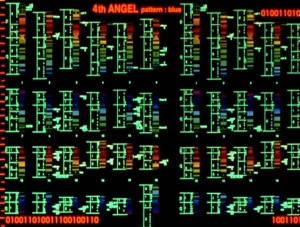Particle-Wave Matter: Difference between revisions
UrsusArctos (talk | contribs) (Cleaned up the errors in the scientific material) |
mNo edit summary |
||
| Line 8: | Line 8: | ||
At the scale of human beings, matter tends to behave as particles (discrete individual units), while electromagnetic radiation (including light) behaves as waves. However, Einstein won the Nobel Prize for proving that | At the scale of human beings, matter tends to behave as particles (discrete individual units), while electromagnetic radiation (including light) behaves as waves. However, Einstein won the Nobel Prize for proving that electromagnetic waves behave as both waves ''and'' particles. The basic units of energy are "quanta", discrete packets of energy which cannot be further subdivided. Later, it was discovered that matter actually behaves as waves too: according to the Heisenberg Uncertainty Principle, electrons move around an atom in such a way that while a discrete "particle", the exact location and direction of a single electron cannot be determined at the same time (this is why the "cloud" model is often used to represent electrons), and they do behave like a wave. Protons and Neutrons, and other heavier subatomic particles represent less of wavelike properties due to their much greater rest mass, a proton having almost two thousand times the rest mass of an electron. Photons(the quanta of electromagnetic energy) are massless particles traveling at the speed of light. | ||
Large concentrations of matter (like a human being) have wave properties, but on far too negligible a scale to measure. | Large concentrations of matter (like a human being) have wave properties, but on far too negligible a scale to measure. | ||
Revision as of 06:11, 16 June 2008

"Particle-wave matter" is the unidentified substance that Angels (and thus, the Evangelions) are composed of. It is not simply an unknown chemical substance: the basic subatomic structure of the matter Angels are composed of is different from anything previously encountered by human science.
As Dr. Ritsuko Akagi explains in Episode 05 after analysis of the corpse of the Angel Shamshel:
- "We do know the Angel is composed of a type of matter characterized by both particulate and wave properties, like light."
At the scale of human beings, matter tends to behave as particles (discrete individual units), while electromagnetic radiation (including light) behaves as waves. However, Einstein won the Nobel Prize for proving that electromagnetic waves behave as both waves and particles. The basic units of energy are "quanta", discrete packets of energy which cannot be further subdivided. Later, it was discovered that matter actually behaves as waves too: according to the Heisenberg Uncertainty Principle, electrons move around an atom in such a way that while a discrete "particle", the exact location and direction of a single electron cannot be determined at the same time (this is why the "cloud" model is often used to represent electrons), and they do behave like a wave. Protons and Neutrons, and other heavier subatomic particles represent less of wavelike properties due to their much greater rest mass, a proton having almost two thousand times the rest mass of an electron. Photons(the quanta of electromagnetic energy) are massless particles traveling at the speed of light.
Large concentrations of matter (like a human being) have wave properties, but on far too negligible a scale to measure.
The "particle-wave matter" that Angels (and Evas) are composed of would, based on Ritsuko's description, appear to be particles with nonzero rest mass- not massless like a photon, and perhaps comparable to a neutrino in mass, showing measurable wave behavior while still being matter.
Ritsuko goes on to explain that:
- "Although (the Angels) are composed of a different form of matter, their actual composition, in terms of the arrangement and spacing of the pattern, falls within a 99.89% match of human genes"
Essentially, while the "atoms" which Angels are made of are not what we would consider "normal" matter (they don't even seem to be composed of an arrangement of protons, neutrons, and electrons), the structure of the "molecules" into which "atoms" of particle-wave matter are arranged is an almost exactly the same as certain molecule forms found in terrestrial life forms, specifically the arrangement of human genetic molecules. Ritsuko refers to results of her scan of the Angel's particle-wave matter as displaying the Angel's "inherent wave pattern".
Notes
- This article's subject does not have any known canonical designation. "Particle-wave matter" is a fan-created term based on Ritsuko's quote.
- Wave-particle duality is a real-world scientific principle.
